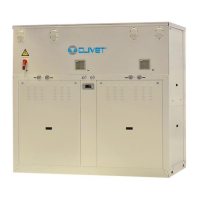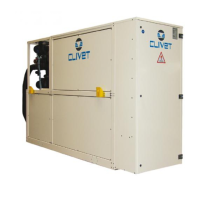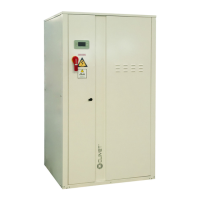Do you have a question about the CLIVET WSHN-XEE2 22.2 and is the answer not in the manual?
Provides correct unit installation, use and maintenance instructions.
Specifies requirements for qualified personnel operating on the unit.
Highlights potential hazards and the need for qualified personnel.
Defines the approved usage for the unit and manufacturer disclaimer.
Details installation considerations and adherence to local regulations.
Emphasizes periodic inspection and maintenance to prevent costs.
Warns that modifications void warranty and manufacturer responsibility.
Instructs immediate unit deactivation and contacting service.
Details the training required for unit operators.
Advises visiting the manufacturer's website for updated product data.
Provides essential information and guidance for the unit user.
Explains how to identify the unit using its serial number label.
Highlights the unique identifier for each unit.
Guides on collecting necessary data for requesting assistance.
Advises observing external packaging instructions for storage.
Provides guidance on verifying weight, identifying critical points, and safe lifting.
Details procedures for unit disassembly, applicable with specific options.
Provides instructions for safely removing unit packaging.
Defines spaces needed for operation, maintenance, and safety.
Lists criteria for choosing installation location and limiting vibration.
Assigns responsibility for evaluating safety valve drain tube installation.
Specifies required water features and consequences of inadequate quality.
Advises on measures to take if unit or connections are near 0°C.
Discusses use of anti-freeze and its impact on pressure drop.
States requirements for project water flow rate.
Details procedures for making hydraulic connections.
Highlights installer's role in defining component type and position.
Specifies filter mesh pitch and installation requirements.
Explains the function of the flow switch and its installation.
Details the steps for filling and operating the unit's hydraulic circuit.
Refers to accessories for hydronic assembly details.
Refers to accessories for domestic hot water valve details.
Refers to details on the natural cooling function.
Describes electrical data found on the serial number label.
Outlines steps for electrical connections and safety precautions.
Provides guidelines for laying out signal and data cables.
Instructs on fixing cables and avoiding contact with hot components.
Illustrates customer-side connections with multilingual labels.
Details connecting the unit to a PC via standard or IP connection.
Describes options for remote unit control and their specifications.
Details Modbus/RS485 communication requirements and setup.
Specifies LonWorks cable types and communication indicators.
Details BACnet IP communication and status indicators.
Indicates operations should be done by qualified technicians.
Lists essential checks to perform before unit start-up.
Details the step-by-step procedure for unit start-up.
Checks for oil stains, pressure, and valve status in the refrigeration circuit.
Ensures water circuit is clean, filled, pressurized, and free of air.
Confirms grounding, conductor tightness, and voltage values.
Details the activation and checks for compressor crankcase heaters.
Ensures remote controls and optional components are connected.
Checks unit operating voltages and electrical load absorptions.
Explains how to limit absorbed electric power via external signal.
Allows automatic set-point regulation based on outside temperature.
Explains how water reset affects setpoint based on climate curve.
Describes ECOSHARE for automatic management of multiple units.
Details operating modes (A, B, C) for networked units.
Checks temperature difference against formula for cooling power.
Discusses compressor rotation direction and potential issues.
Warns about damages from prolonged operation at reduced load.
Identifies operating conditions for unit monitoring.
Provides instructions for installers regarding PED directive.
Describes the function of the unit's LED indicators.
Explains the variables and their descriptions shown on the display.
Lists the control keys and their corresponding functions.
Allows changing unit operational state (OFF, ECO, ON, Pump On).
Enables switching between Cool and Heat modes.
Details the procedure for adjusting cooling and heating setpoints.
Allows setting up to 6 events per weekday for unit operation.
Procedure to enable the scheduler function.
Provides options to display machine state and circuit information.
Allows configuring keyboard settings and local connections.
Procedures for identifying, resetting, and managing unit alarms.
Stresses that maintenance must be done by authorized centers.
Recommends inspection frequency based on unit usage.
Advises creating a booklet to log unit interventions and data.
Provides guidance for unit inactivity and re-start.
Details the importance and method for cleaning the water side exchanger.
Specifies checks for leaks, bearing status, and terminal covers.
Instructs to check insulation condition and renew seals if needed.
Ensures no impurities obstruct water passage through the filter.
Details checks for flow switch operations and palette cleaning.
Information regarding the compressor supply line shut-off valve.
Details checks for closure and operation of the crankcase heater.
Information on advanced scroll temperature protection for compressors.
Details steps for evacuating and discharging the system.
Explains compliance with the directive on waste electrical equipment.
Illustrates different user side hydronic unit configurations.
Illustrates different source side hydronic assembly configurations.
Details parameter settings and connections for a 3-way modulating valve.
Details parameter settings and connections for a 2-way modulating valve.
Details parameter settings and connections for the domestic hot water valve.
Explains enabling Natural Cooling using source water for cold production.
Lists common situations not controlled by the manufacturer that pose risks.
Presents technical data for the groundwater version of the unit.
Presents technical data for the geothermic version of the unit.
Lists minimum and maximum admissible water flow rates for correct operation.
Details calibration values for overload and control devices.
Provides correct unit installation, use and maintenance instructions.
Specifies requirements for qualified personnel operating on the unit.
Highlights potential hazards and the need for qualified personnel.
Defines the approved usage for the unit and manufacturer disclaimer.
Details installation considerations and adherence to local regulations.
Emphasizes periodic inspection and maintenance to prevent costs.
Warns that modifications void warranty and manufacturer responsibility.
Instructs immediate unit deactivation and contacting service.
Details the training required for unit operators.
Advises visiting the manufacturer's website for updated product data.
Provides essential information and guidance for the unit user.
Explains how to identify the unit using its serial number label.
Highlights the unique identifier for each unit.
Guides on collecting necessary data for requesting assistance.
Advises observing external packaging instructions for storage.
Provides guidance on verifying weight, identifying critical points, and safe lifting.
Details procedures for unit disassembly, applicable with specific options.
Provides instructions for safely removing unit packaging.
Defines spaces needed for operation, maintenance, and safety.
Lists criteria for choosing installation location and limiting vibration.
Assigns responsibility for evaluating safety valve drain tube installation.
Specifies required water features and consequences of inadequate quality.
Advises on measures to take if unit or connections are near 0°C.
Discusses use of anti-freeze and its impact on pressure drop.
States requirements for project water flow rate.
Details procedures for making hydraulic connections.
Highlights installer's role in defining component type and position.
Specifies filter mesh pitch and installation requirements.
Explains the function of the flow switch and its installation.
Details the steps for filling and operating the unit's hydraulic circuit.
Refers to accessories for hydronic assembly details.
Refers to accessories for domestic hot water valve details.
Refers to details on the natural cooling function.
Describes electrical data found on the serial number label.
Outlines steps for electrical connections and safety precautions.
Provides guidelines for laying out signal and data cables.
Instructs on fixing cables and avoiding contact with hot components.
Illustrates customer-side connections with multilingual labels.
Details connecting the unit to a PC via standard or IP connection.
Describes options for remote unit control and their specifications.
Details Modbus/RS485 communication requirements and setup.
Specifies LonWorks cable types and communication indicators.
Details BACnet IP communication and status indicators.
Indicates operations should be done by qualified technicians.
Lists essential checks to perform before unit start-up.
Details the step-by-step procedure for unit start-up.
Checks for oil stains, pressure, and valve status in the refrigeration circuit.
Ensures water circuit is clean, filled, pressurized, and free of air.
Confirms grounding, conductor tightness, and voltage values.
Details the activation and checks for compressor crankcase heaters.
Ensures remote controls and optional components are connected.
Checks unit operating voltages and electrical load absorptions.
Explains how to limit absorbed electric power via external signal.
Allows automatic set-point regulation based on outside temperature.
Explains how water reset affects setpoint based on climate curve.
Describes ECOSHARE for automatic management of multiple units.
Details operating modes (A, B, C) for networked units.
Checks temperature difference against formula for cooling power.
Discusses compressor rotation direction and potential issues.
Warns about damages from prolonged operation at reduced load.
Identifies operating conditions for unit monitoring.
Provides instructions for installers regarding PED directive.
Describes the function of the unit's LED indicators.
Explains the variables and their descriptions shown on the display.
Lists the control keys and their corresponding functions.
Allows changing unit operational state (OFF, ECO, ON, Pump On).
Enables switching between Cool and Heat modes.
Details the procedure for adjusting cooling and heating setpoints.
Allows setting up to 6 events per weekday for unit operation.
Procedure to enable the scheduler function.
Provides options to display machine state and circuit information.
Allows configuring keyboard settings and local connections.
Procedures for identifying, resetting, and managing unit alarms.
Stresses that maintenance must be done by authorized centers.
Recommends inspection frequency based on unit usage.
Advises creating a booklet to log unit interventions and data.
Provides guidance for unit inactivity and re-start.
Details the importance and method for cleaning the water side exchanger.
Specifies checks for leaks, bearing status, and terminal covers.
Instructs to check insulation condition and renew seals if needed.
Ensures no impurities obstruct water passage through the filter.
Details checks for flow switch operations and palette cleaning.
Information regarding the compressor supply line shut-off valve.
Details checks for closure and operation of the crankcase heater.
Information on advanced scroll temperature protection for compressors.
Details steps for evacuating and discharging the system.
Explains compliance with the directive on waste electrical equipment.
Illustrates different user side hydronic unit configurations.
Illustrates different source side hydronic assembly configurations.
Details parameter settings and connections for a 3-way modulating valve.
Details parameter settings and connections for a 2-way modulating valve.
Details parameter settings and connections for the domestic hot water valve.
Explains enabling Natural Cooling using source water for cold production.
Lists common situations not controlled by the manufacturer that pose risks.
Presents technical data for the groundwater version of the unit.
Presents technical data for the geothermic version of the unit.
Lists minimum and maximum admissible water flow rates for correct operation.
Details calibration values for overload and control devices.











